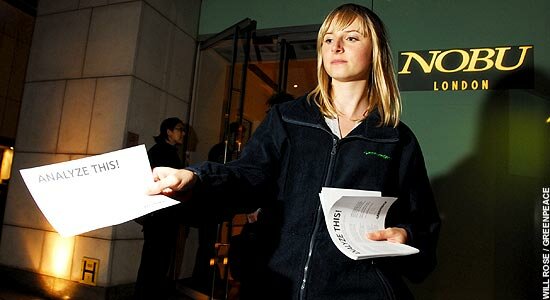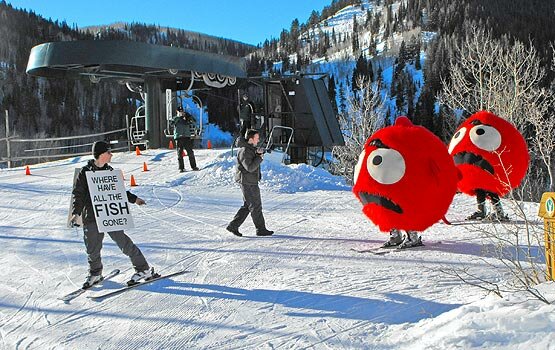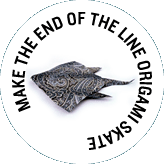Tag Archive for 'seafood'
The UK’s first online seafood restaurant guide – www.fish2fork.com – is launched today.

Fish2fork is the UK's first online seafood restaurant guide
The interactive guide aims to rate restaurants not just on the usual criteria of how good their seafood is but, perhaps more importantly, on what impact its capture has on our oceans and marine life.
Visitors to the site will find information about seafood restaurants across the UK and will be encouraged to ask questions about the fish they are offered when they dine out.
They can then easily upload their own view of the restaurant’s commitment to sustainability onto the website and help give it a simple rating score - blue fish for good and red fish for bad – on a sliding scale.
Fish2fork.com, run by the same people who produced The End of the Line, has reviewed and rated more than 100 restaurants initially but is relying on diners to help the website grow into an authoritative reference guide.
Among those who scored bottom in the guide, denoted by five red fish skeletons, included J Sheekey, the restaurant owned by the company that also owns the Ivy and the Caprice, and Nobu, the Japanese fusion chain. Rick Stein, the TV chef, rated half a red fish skeleton, which indicated he served several “fish to avoid.”
The Loch Fyne chain and the Michelin-starred Hibiscus in London’s West End scored joint highest with three blue fish.
The website’s aim is not to persuade people to stop eating fish – quite the contrary – it wants everybody to continue enjoying seafood. But the world’s fish stocks are under pressure like never before and if future generations are to share the same privilege, old habits have to change.
As fish2fork.com editor Charles Clover, revealed in his book on which The End of the Line film was based, as many as 80 per cent of the world’s fish stocks are fully or over-exploited and some fish species, such as the bluefin tuna or the beluga sturgeon, are now listed as critically endangered.
The cavalier attitude to our oceans and the seafood they contain has to change if the appalling prospect of a world without fish is to be avoided. And diners, by making the right choices about the fish they eat, have a powerful economic weapon they can use in bringing about that all-important change.
Fish2fork.com has been set up specifically to help diners make informed decisions before they visit a seafood restaurant on which strive to provide the most sustainable fish to eat and which serve mostly fish to avoid.
Using the International Union for Conservation of Nature (IUCN) Red List and the Marine Conservation Society (MCS) list of species to avoid, the website earlier this summer benchmarked the menus of more than 100 restaurants. They were then contacted and asked to complete a questionnaire so that a rating could be given.
The questions were designed to assess a restaurant’s sourcing policy, for instance, whether it offered wild or farmed fish, whether its shellfish were dredged or whether it offered species of fish which were either endangered or under threat because of over-fishing.
Where a restaurant declined or was unable to complete the questionnaire it was filled in by fish2fork.com staff using its online menu as a source of information.
The survey produced some startling results:
- Almost 90 per cent of restaurants are serving at least one “fish to avoid” species.
- Some Michelin-starred restaurants were amongst the worst offenders and a quarter of those surveyed are serving fish regarded as endangered.
- More than one in three restaurants served three or more species from the “fish to avoid” list.
Charles Clover, the editor of fish2fork.com, said: “Some restaurants still have not grasped that sustainability is now part of the definition of good food. You don’t want to eat a wonderful meal and have nightmares about the species you have pushed a little further towards extinction.
“This new guide shows the wonderful work some chefs and proprietors are doing with fishermen to make sure that they source fish of the highest quality caught in the most selective ways.
“It also shows the awful dark side of gastronomy, chefs who place an ephemeral taste for which they can charge the Earth above the survival of whole species and ecosystems.
“What few people know is that the supermarkets have made huge strides in recent years to get endangered fish off their shelves.
“The trouble is, these species very often remain on the menu at white tablecloth restaurants who haven’t yet had the searchlight of public opinion directed at the dark corners of their menus, where there are some real horror stories.”
Willie Mackenzie, oceans campaigner for Greenpeace UK, said: “As consumers we all have an impact on the oceans every time we eat a forkful of fish.
“We can make a real difference by what we buy, and we need to hold the retailers and restaurateurs to account for their fish sourcing policies. If we want to eat fish in years to come, then we have to radically overhaul the way we are fishing today – and your fork is the front line.”
Sam Wilding, the Marine Conservation Society’s fisheries officer, said: “It is encouraging to see Fish2fork highlighting the issue of seafood sustainability to restaurants and chefs, and giving the concerned consumer a voice.
“MCS provides consumers with free advice on seafood sustainability, through our pocket good fish guides and fishonline.org and is pleased to see our advice incorporated into the Fish2Fork campaign.”
Visitors to fish2fork.com can download the same questionnaire used in the survey to rate their own restaurant. Alternatively, they can ‘rat’ on a restaurant they suspect of malpractice, or ‘pat’ a restaurant they think deserves recognition by sending a quick email.
The website also features a ‘widget’ which will enable visitors to look up and check the conservation status of most species of fish they are likely to encounter in a restaurant.
For more information go to www.fish2fork.com.

There have been many articles and reviews featuring The End of the Line this week following the film’s release in the United States on 19th June.
Entertainment Weekly’s review of the film says: “Fishermen are no longer simply ”fishing.” They’re subjecting threatened species to the equivalent of carpet bombing, and this passionate ecological documentary, The End of the Line, spells out the problem in clear, urgent, prosaic terms.”
Twilight Greenaway, writing for The Ethicurean, suggests that the film missed one point that would help sustain life in the oceans - eating less fish. She went on to say: “Since seeing the film, the possibility of thriving oceans once again full of wild fish of all colours and sizes seems ever more compelling.
“With that image in my mind, giving up most seafood — seeing it as a rare treat, as Mark Bittman wrote recently in the New York Times — until then doesn’t felt like much of a sacrifice.” Continue reading ‘News and blogs round up for The End of the Line’

The End of the Line has still been receiving plenty of coverage following its UK release and in the run up to its US launch. Here we bring together the latest news and a few older pieces that slipped through the net.
The Guardian covers the film and the issue of fish stocks again. In the Environment section, Felicity Lawrence, writes: ”The supermarkets have increased their targets for sustainable fish, and The End of the Line’s film release has prompted a flurry of announcements – most notably from M&S and Pret a Manger – to move even faster . . . .
“There is reason to hope that fish stocks can still recover, but we need to keep asking for sustainable catches. Keep the pressure up.” Continue reading ‘The End of the Line coverage following the film’s UK release’

The End of the Line film asks that consumers should choose only sustainable seafood - which means, first and foremost, that they agree to avoid eating actively endangered species, for example, the bluefin and bigeye tunas and the common skate.

Dear Chef / Restaurant Owner seafood response card
To help communicate this message to chefs and restaurant owners that we want to buy only sustainable seafood, we have drawn up a downloadable leaflet which can be printed easily on a single sheet of A4 so customers can let restaurants know what they think of the seafood on a restaurant’s menu after dining there.
Carry it with you when you go out to dinner.
The leaflet says: As a customer it is essential to me that you sell seafood that is not caught or farmed in ways that damage the ocean or its species.
It enables customers to rate the restaurant, by ticking one of the following options:
- I notice that some of the seafood you serve is caught or farmed in ways that is likely to harm the ocean and the wildlife in it
- Thank you for offering sustainable seafood. I look forward to recommending your business to my family and friends.
The card is then left after the meal, or with the bill.

This week has seen a dramatic increase in the coverage for The End of the Line and related fishing issues in the run up to the World Ocean Day Screenings.
Many of the national daily papers have covered the film or the Nobu decision to continue selling bluefin tuna - a subject brought into the spotlight by The End of the Line campaign and Greenpeace.
In an extensive comment piece for The Independent, Johann Hari, asks whether we will be the generation that runs out of fish.
He writes: “In the babbling Babel of 24/7 news . . . the slow-motion stories that will define our age are often lost. An extraordinary documentary released next week, The End of the Line, forces us to stop, and see.”
The Telegraph reports that Sienna Miller, Charlize Theron, Jemima Khan, Woody Harrelson, Laura Bailey, Alicia Silverstone, Zac Goldsmith, Sting and his wife Trudie Styler have jointly written to Nobu asking him to remove bluefin tuna from the restaurant’s menus, so they can “dine with a clear conscience”.
The Sun also carries the story saying: “Sienna Miller blasted a top London restaurant for putting endangered bluefin tuna on its menu.” Continue reading ‘The End of the Line focuses spotlight on celebrity reaction to bluefin tuna on Nobu menu’

The celeb-favourite sushi restaurant Nobu is back in the media spotlight this week, but with column inches devoted to bluefin tuna rather than A-list diners.

Greenpeace activists give out leaflets outside Nobu protesting against the restaurant selling bluefin tuna
As Greenpeace revealed last year, Nobu, who pride themselves as market leaders and an exclusive venue, were serving up bluefin tuna as sushi.
Bluefin is an endangered species, like rhinos, tigers, or gorillas, and after it was pointed out to them last September (although the species had been on the IUCN red list of endangered species for 12 years, had they bothered to check), they gave assurances that they would do something about it.
But sadly it seems Nobu can’t be bothered. They know they are serving up endangered species, and helping to push them towards extinction, but profit comes first, right? Continue reading ‘Robert De Niro, what are you waiting for?’

Charles Clover, author of The End of the Line and one of the stars of the film, has talked to Fork in the Road, the food blog for Village Voice in New York.
He outlines his concerns about overfishing, the solutions that are currently in place and why we shouldn’t assume we live in a world of plenty. He also talks about whether he eats fish, he says:
“Yes, but less than I did. I am mightily confused by whether any farmed fish is sustainable and I would just prefer to eat the little fish that they feed to carnivorous fish . . . . I like mackerel, which is now MSC-certified, and have learned that it makes wonderful sushi straight out of the sea with English mustard, as Hugh Fearnley-Whittingstall serves it.”
To read the full interview see No Fish by 2048? The End of the Line–Interview with Journalist Charles Clover on the Fork in the Road on Village Voice.

So, what’s the movie we’re here in Sundance with about then? Well it’s an adaptation of Charles Clover’s brilliant book on overfishing, The End Of The Line, which is an evocative, and shocking portrayal of what we have done, and are doing to our oceans – just to put seafood on our plates.

Greenpeace guppies spread their message about overfishing on the ski slopes
Seafood is a global issue and practically nowhere on our seas is beyond human reach now – the movie gives an overview of the main issues like overfishing, destructive fishing and poor management.
The movie takes a global look at the true price we’re paying for our seafood, vividly illustrating the impact we’re having, but that very few of us even realise.
Continue reading ‘Is it The End Of The Line?’


![]()





